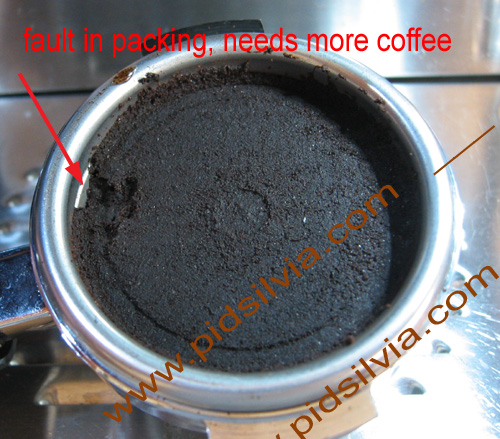![]()
| HOME | How to Order |
|
Clumping - Back
Use a good grinder, or keep reading.
Clumps in coffee grounds are very deceiving to the eye and often to the touch. We really can’t tell how dense they are and just how likely they are to detract from uniform extraction. The density of the clumps has a direct relation to the degree of negative effect. What looks like a uniform puck is an illusion if portions of the puck are denser than others. Light powder and dense clumps ruin the uniformity of the extraction.
Many will tell you clumps in the puck are not a problem. And, like cracks, there won’t be a problem if they get the right treatment before the extraction--or if extraction quality is not the first priority. But were you ever told the right treatment for clumps to achieve a uniform puck? I bet you weren't.
Dense clumps in the coffee grounds are like ice cubes in snow. Like sugar cubes in sugar. To see how they behave, take a few sugar cubes and the same amount of loose granulated sugar and shake them left and right (side to side) in a cup. Then pour the “mix” on a small plate and shake side to side. Or pour it from cup to cup. You will see that the cubes tend to gather in one area. ....I think you will quickly understand that it can be hard to have uniform density in the puck if you have clumps.
Some grinders tend to produce more clumping than others. Some commercial grinders, for the sake of fast grinding and eliminating static, compromise in the design and deliver the coffee grounds, all in clumps.
So what can you do if you think that you have a clumping problem? Sifting the coffee grinds to break the clumps before brewing works well, but is not practical (try it as an experiment and you will see that it solves the clumping problem).
[Pictures of under side to show uneven brew because of clumps -- coming soon]
In the picture below you can see a fault in the cake because of clumping.
You will not have this with a good grinder.

More sophisticated espresso machines could reduce or mask the clumping problem.
But if you are a home user who is just looking for a good, easy way of pulling a few good espresso shots a day and you really want to eliminate the bad effects of clumping, you should know that, as of today, finding a clumpless grinder can be a challenge. If you think you have a clumping problem (and you were able to fix it by sifting), you can minimize the clumping problem by (i) increasing the dose using a larger basket, (ii) cleaning your grinder chute periodically, and (iii) tamping with a rolling/rocking motion, with a flattening tamp “finish”. Preinfusion may help a little by saturating the grinds and clumps producing a more even density in the puck but in many cases will do more harm than good. Do not shake the grind side to side before tamping (remember the sugar cubes). And if you decide to buy a new grinder, look for short chutes that send grounds, without restrictive elbows, directly to the basket from the grind mechanism. In general, stay away from the large commercial grinders which often have large chutes and screens (the large chute is not a big issue for commercial uses because so much coffee is ground that the coffee on top keeps quickly pushing the fresh coffee through). But remember that you need to be looking at top quality grinders to begin with; don’t buy a grinder just because it has a short, straight chute.
Keep in mind that busy coffee shops prepare 400 or more espresso shots a day (clumps don’t matter for drip brew) and so they need to use an extremely durable commercial grinder like a Mazzer that can grind fast, day in and day out. The clumps might be an annoyance for the baristas, but they will use a bigger basket and a greater dose than normal (16-7g could go to 20-22g), minimizing the clump effect by increasing the filtering effect of the puck. And if the quality of the shots is masked with milk and sweeteners added to the cup, most customers will probably not notice the quality of the extraction.
|
|